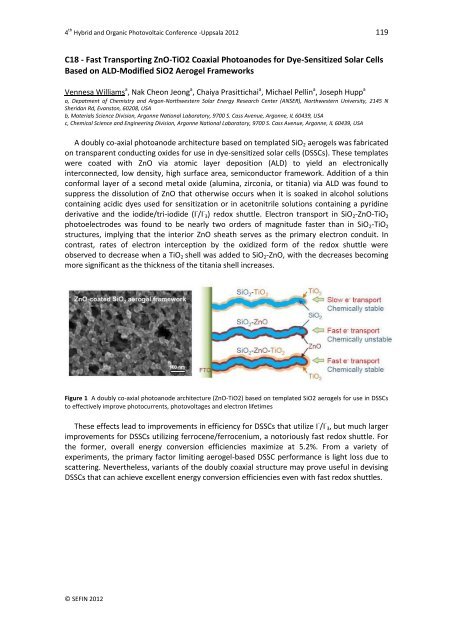HOPV12 - Blogs
HOPV12 - Blogs
HOPV12 - Blogs
Create successful ePaper yourself
Turn your PDF publications into a flip-book with our unique Google optimized e-Paper software.
4 th Hybrid and Organic Photovoltaic Conference -Uppsala 2012 119<br />
C18 - Fast Transporting ZnO-TiO2 Coaxial Photoanodes for Dye-Sensitized Solar Cells<br />
Based on ALD-Modified SiO2 Aerogel Frameworks<br />
Vennesa Williams a , Nak Cheon Jeong a , Chaiya Prasittichai a , Michael Pellin a , Joseph Hupp a<br />
a, Depatment of Chemistry and Argon-Northwestern Solar Energy Research Center (ANSER), Northwestern University, 2145 N<br />
Sheridan Rd, Evanston, 60208, USA<br />
b, Materials Science Division, Argonne National Laboratory, 9700 S. Cass Avenue, Argonne, IL 60439, USA<br />
c, Chemical Science and Engineering Division, Argonne National Laboratory, 9700 S. Cass Avenue, Argonne, IL 60439, USA<br />
A doubly co-axial photoanode architecture based on templated SiO2 aerogels was fabricated<br />
on transparent conducting oxides for use in dye-sensitized solar cells (DSSCs). These templates<br />
were coated with ZnO via atomic layer deposition (ALD) to yield an electronically<br />
interconnected, low density, high surface area, semiconductor framework. Addition of a thin<br />
conformal layer of a second metal oxide (alumina, zirconia, or titania) via ALD was found to<br />
suppress the dissolution of ZnO that otherwise occurs when it is soaked in alcohol solutions<br />
containing acidic dyes used for sensitization or in acetonitrile solutions containing a pyridine<br />
derivative and the iodide/tri-iodide (I - /I - 3) redox shuttle. Electron transport in SiO2-ZnO-TiO2<br />
photoelectrodes was found to be nearly two orders of magnitude faster than in SiO2-TiO2<br />
structures, implying that the interior ZnO sheath serves as the primary electron conduit. In<br />
contrast, rates of electron interception by the oxidized form of the redox shuttle were<br />
observed to decrease when a TiO2 shell was added to SiO2-ZnO, with the decreases becoming<br />
more significant as the thickness of the titania shell increases.<br />
Figure 1 A doubly co-axial photoanode architecture (ZnO-TiO2) based on templated SiO2 aerogels for use in DSSCs<br />
to effectively improve photocurrents, photovoltages and electron lifetimes<br />
These effects lead to improvements in efficiency for DSSCs that utilize I - /I - 3, but much larger<br />
improvements for DSSCs utilizing ferrocene/ferrocenium, a notoriously fast redox shuttle. For<br />
the former, overall energy conversion efficiencies maximize at 5.2%. From a variety of<br />
experiments, the primary factor limiting aerogel-based DSSC performance is light loss due to<br />
scattering. Nevertheless, variants of the doubly coaxial structure may prove useful in devising<br />
DSSCs that can achieve excellent energy conversion efficiencies even with fast redox shuttles.<br />
© SEFIN 2012


